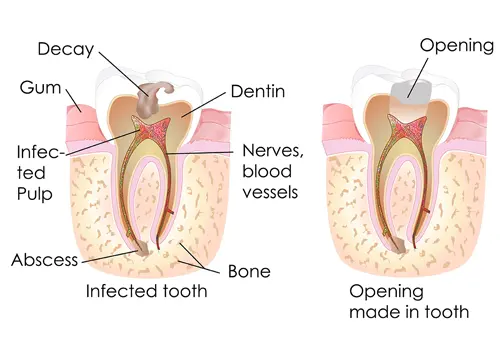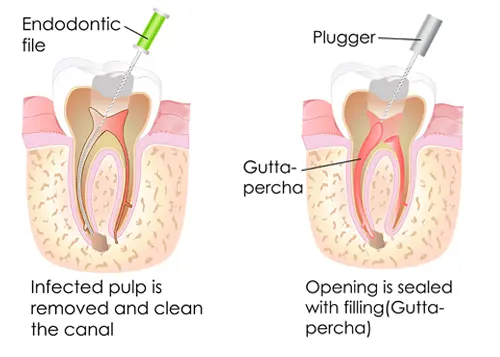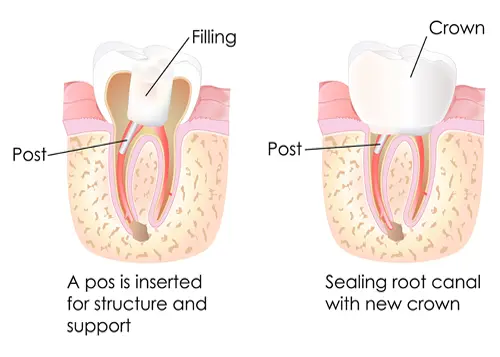Root Canal Treatment
Restore Your Teeth
Root canal treatment help save the teeth which otherwise needs removal. This treatment involves repairing and saving a badly damaged or infected tooth instead of removing it.
What happens during a root canal treatment?
Illustration below shows the steps involved in a root canal treatment.

Step-1

Step-2

Step-3
The Procedure
The endodontist or dentist removes the damaged area of the tooth, cleans and disinfects it. Finally, the dentist fills the canal and seals it. The common causes include infection deep within the tooth. This usually occurs when the pulp inside the tooth becomes infected with bacteria because of an untreated cavity or severe injury. The term ‘root canal’ comes from the canals inside the tooth’s root. The dental pulp inside the canal can become infected a cracked tooth or more often due to deep cavity. The treatment involves removing the infected pulp, cleaning and disinfecting it. The dentist then fills and seals it.
What is dental pulp?
The pulp is the soft tissue within the center of the tooth that runs through the root of the tooth. It contains the nerve, blood vessels and tissue fibres.
Will removing the dental pulp affect the function of the tooth?
Dental pulp regulates the growth and development of the tooth during childhood. Once the tooth is fully formed, a tooth can function without its pulp. After root canal treatment the tooth is pulpless, but it is not a dead tooth. Therefore, removing the dental pulp will not affect the function of the tooth.
Common causes of pulp damage
The most common cause of pulp damage is deep tooth decay which allows bacteria to reach into the pulp. The pulp may then become inflamed or infected.Products of infection may then spread through the opening at the tip of the root into the surrounding bone – an abscess could result and this may cause pain and swelling. Not all abscesses cause pain or swelling.
Other causes of pulp damage include: traumatic blows to teeth, loose fillings,excessive wear of teeth, cracked teeth and gum disease. These processes can also lead to infection of the pulp.
Access is gained into the tooth, removing decay and allowing for endodontic treatment to be commenced. During endodontic treatment, the infected or damaged pulp is removed from the inside (i.e. the root canal) of the tooth via the small access hole. The dentist then cleans, disinfects seals the root canals. The next stage is to seal (fill) the root canals with a filling material to prevent re-infection.

About Dr, Ajay
Dr. Ajay is a member of the Australian Dental Association and Australian Society of Implant Dentistry. Dr. Ajay keeps abreast with the advances in dentistry by attending course and lectures in Australia and around the world. Furthermore, as a practicing dentist, he loves to listen to your questions, concerns and explain all your treatment options. Call (07) 4151 7305 for an appointment.
Payment Options / Plans
Payment plans are essentially loans, which can support you in managing the high cost of dental treatment. Rather than paying for your dental work in an upfront lumpsum, a payment plan allows you to pay in instalments over a period of time. We have onboard, payment plan service providers who will make your payment plan’s instalments even more affordable.
There are several payment options available at our surgery including Cash, Cheque, EFTPOS, Credit Card, HICAPS, AMEX and Direct Deposit.







